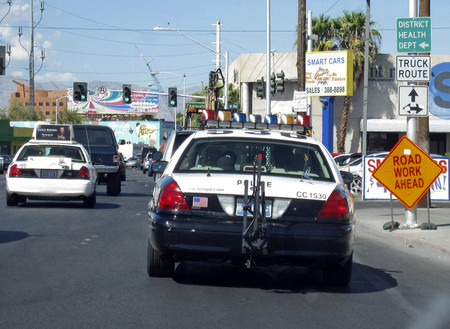Some delays are a matter of life and death

Pylons, dented orange and white barrels and never-ending congestion are enough to drive any motorist in this town nuts these days.
Discovering an alternate route free of construction zones is reason to celebrate. And sharing this secret back-way with your mother isn’t an option for fear the rest of the world will take note.
Then, alas, it happens: That coveted route also becomes littered with orange cones and detour signs, sending your blood pressure soaring.
What we need to do is breathe and realize this: It is not a life or death situation whether we are late to work, or dinner or even a pricey show on the Las Vegas Strip.
That isn’t the case when it comes to emergency crews experiencing those same frustrations. To them, timing, good timing, is everything.
“Anything that impedes our response time can truly make a difference between someone’s life or death, and you know that when you’re going to a call,” said Scott Allison of the Clark County Fire Department. “You want to get there and you want to help. When you can’t get there as fast as you’d like, it’s frustrating.”
In his 20-plus years as a Las Vegas resident, Allison has never before encountered the challenge posed by all the construction zones.
“It seems like I’ve seen more road projects than in all the years I’ve lived here,” he said.
Allison works out of Station 18, on Flamingo Road, which for weeks has been torn up as NV Energy installs underground power lines between Interstate 15 and Koval Lane. Engines struggle to maneuver through the construction zones and around traffic in an effort to meet their target response time of less than seven minutes.
It’s not easy. They have hit major backups just west of the station around Las Vegas Boulevard and found themselves flat-out stuck.
“We shut down our lights and sirens until we are able to move with the traffic,” Allison said. “If it’s a life-threatening call, and we know we’re going to be delayed, you want to start a unit from the other end.”
Victims of heart attacks also can be victims of these delays. Arriving within six minutes is crucial.
“The save rate isn’t very good, and it is usually because of the response time,” Allison said, adding that this is a nationwide problem.
So, how are the emergency services coping with the lane restrictions, closed streets, barricaded offramps and heavier side-street traffic?
“It’s posed a challenge, there is no secret about that whatsoever,” said Chad Henry, operations manager for American Medical Response.
Both AMR and MedicWest, Clark County’s two ambulance companies, are required by their franchises with Clark County government to meet response times of under 12 minutes.
Because of the construction on I-15 and lane closures on Cheyenne Avenue, MedicWest was forced to deploy additional vehicles to ensure they could make it to a call. Like AMR, MedicWest strategically stations its ambulances based on historical information that provides statistics on call patterns and locations.
Although both companies said they have met their target response times, they acknowledged that it hasn’t been a smooth ride.
For AMR, the problematic areas have been Valley View and Oakey boulevards and Oakey and Rancho Drive.
“Fortunately they’ve left Industrial (Road) alone. It’s been a lifesaver for us,” Henry said. Literally.
Astonishingly, these emergency crews don’t receive any more information from government entities overseeing road projects than do the average motorists. Like us, the ambulance franchises rely on government Web sites, which aren’t always updated and are not entirely accurate.
The cities and counties haven’t reached out to the emergency crews, and crews haven’t asked.
“Unfortunately, we don’t have a formal communication plan,” Henry said.
But why? It seems as though this would be a priority if lives are in danger.
“I wish I had an answer,” Henry said.
And so in most cases, it comes down to word of mouth: ambulance drivers, officers and firefighters telling other crews which thoroughfares to avoid and suggesting alternate routes.
That is a bit easier for the Las Vegas Metropolitan Police Department, which has more vehicles on the road and whose officers work specific areas.
“You stay in the same area and know that area like the back of your hand,” police spokesman Bill Cassell said. “Those guys are very aware of construction in their area. They do like everybody else does; they have a mental plan in place if they have to get from point A to point B. The first thing we do is make ourselves aware of construction.”
Emergency crews are learning to deal with their struggles, but emphasized that we can help out, too.
If you find yourself in a construction zone and see the lights behind you, do your best to pull as far to the side as possible and the emergency vehicles will find a way to squeeze by.
“Hopefully, people see our lights and think about how fast they’d like to see us respond if it was their family member,” Allison said.
If you have a question, tip or tirade, call the Road Warrior at 387-2904, or e-mail her at roadwarrior@reviewjournal.com or apacker@reviewjournal.com. Please include your phone number.